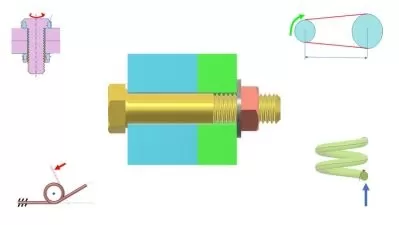HEAT EXCHANGERS : Selection, Rating, and Thermal Design- II
EasyShiksha Learning
5:21:33
Description
HEAT EXCHANGERS : Selection, Rating, and Thermal Design
What You'll Learn?
- Understand the principles of heat transfer and thermodynamics as applied to heat exchanger design.
- Learn the different types of heat exchangers, including shell-and-tube, plate-and-frame, and air-cooled exchangers, and be able to select the appropriate heat e
- Gain knowledge of heat exchanger sizing and rating methods, including log mean temperature difference (LMTD), effectiveness-NTU method, and heat exchanger perfo
- Learn the steps involved in thermal design of heat exchangers, including the calculation of heat transfer coefficients, determination of flow arrangements, and
Who is this for?
More details
DescriptionHEAT EXCHANGERS: Selection, Rating, and Thermal Design is a course that provides an in-depth understanding of the different types of heat exchangers, their selection, rating and thermal design methodologies. The course covers the fundamental principles of heat transfer, fluid mechanics, and thermodynamics as they pertain to heat exchanger design. Students will learn about the various types of heat exchangers such as shell and tube, plate and frame, and air cooled heat exchangers, and their suitability for different applications. They will also learn about the different methods used to rate and select heat exchangers, including log mean temperature difference, effectiveness-NTU method, and thermal design. Additionally, the course will cover the thermal design of heat exchangers including the use of design codes, the design of heat exchanger components, and the use of computer-aided design tools. The course is intended for Mechanical and Chemical Engineering students and professionals in related fields such as Aerospace and Energy engineering.
Topics we covered in this course From Module 8 to Module 13:
8. Design Correlations for Condensers and Evaporators
8.1 Introduction
8.2 Condensation
8.3 Film Condensation on a Single Horizontal Tube
8.3.1 Laminar Film Condensation
8.3.2 Forced Convection
8.4 Film Condensation in Tube Bundles
8.5 Condensation inside Tubes
8.6 Flow Boiling
9. Shell-and-Tube Heat Exchangers
9.1 Introduction
9.2 Basic Components
9.3 Basic Design Procedure of a Heat Exchanger
9.4 Shell-Side Heat Transfer and Pressure Drop
10. Compact Heat Exchangers
10.1 Introduction
10.2 Heat Transfer and Pressure Drop
11. Gasketed-Plate Heat Exchangers
11.1 Introduction
11.2 Mechanical Features
11.3 Operational Characteristics
11.4 Passes and Flow Arrangements
11.5 Applications
11.6 Heat Transfer and Pressure Drop Calculations
11.7 Thermal Performance
12. Condensers and Evaporators
12.1 Introduction
12.2 Shell and Tube Condensers
12.3 Steam Turbine Exhaust Condensers
12.4 Plate Condensers
12.5 Air-Cooled Condensers
12.6 Direct Contact Condensers
12.7 Thermal Design of Shell-and-Tube Condensers
12.8 Design and Operational Considerations
12.9 Condensers for Refrigeration and Air-Conditioning
12.10 Evaporators for Refrigeration and Air-Conditioning
12.11 Thermal Analysis
12.12 Standards for Evaporators and Condensers
13. Polymer Heat Exchangers
13.1 Introduction
13.2 Polymer Matrix Composite Materials (PMC)
13.3 Nanocomposites
13.4 Application of Polymers in Heat Exchangers
13.5 Polymer Compact Heat Exchangers
13.6 Potential Applications for Polymer Film Compact Heat Exchangers
13.7 Thermal Design of Polymer Heat Exchangers
Who this course is for:
- Engineers and technicians who work in the design, selection, and operation of heat exchangers.
- Industry professionals who are looking to stay up-to-date with the latest developments in heat exchanger technology and design practices.
HEAT EXCHANGERS: Selection, Rating, and Thermal Design is a course that provides an in-depth understanding of the different types of heat exchangers, their selection, rating and thermal design methodologies. The course covers the fundamental principles of heat transfer, fluid mechanics, and thermodynamics as they pertain to heat exchanger design. Students will learn about the various types of heat exchangers such as shell and tube, plate and frame, and air cooled heat exchangers, and their suitability for different applications. They will also learn about the different methods used to rate and select heat exchangers, including log mean temperature difference, effectiveness-NTU method, and thermal design. Additionally, the course will cover the thermal design of heat exchangers including the use of design codes, the design of heat exchanger components, and the use of computer-aided design tools. The course is intended for Mechanical and Chemical Engineering students and professionals in related fields such as Aerospace and Energy engineering.
Topics we covered in this course From Module 8 to Module 13:
8. Design Correlations for Condensers and Evaporators
8.1 Introduction
8.2 Condensation
8.3 Film Condensation on a Single Horizontal Tube
8.3.1 Laminar Film Condensation
8.3.2 Forced Convection
8.4 Film Condensation in Tube Bundles
8.5 Condensation inside Tubes
8.6 Flow Boiling
9. Shell-and-Tube Heat Exchangers
9.1 Introduction
9.2 Basic Components
9.3 Basic Design Procedure of a Heat Exchanger
9.4 Shell-Side Heat Transfer and Pressure Drop
10. Compact Heat Exchangers
10.1 Introduction
10.2 Heat Transfer and Pressure Drop
11. Gasketed-Plate Heat Exchangers
11.1 Introduction
11.2 Mechanical Features
11.3 Operational Characteristics
11.4 Passes and Flow Arrangements
11.5 Applications
11.6 Heat Transfer and Pressure Drop Calculations
11.7 Thermal Performance
12. Condensers and Evaporators
12.1 Introduction
12.2 Shell and Tube Condensers
12.3 Steam Turbine Exhaust Condensers
12.4 Plate Condensers
12.5 Air-Cooled Condensers
12.6 Direct Contact Condensers
12.7 Thermal Design of Shell-and-Tube Condensers
12.8 Design and Operational Considerations
12.9 Condensers for Refrigeration and Air-Conditioning
12.10 Evaporators for Refrigeration and Air-Conditioning
12.11 Thermal Analysis
12.12 Standards for Evaporators and Condensers
13. Polymer Heat Exchangers
13.1 Introduction
13.2 Polymer Matrix Composite Materials (PMC)
13.3 Nanocomposites
13.4 Application of Polymers in Heat Exchangers
13.5 Polymer Compact Heat Exchangers
13.6 Potential Applications for Polymer Film Compact Heat Exchangers
13.7 Thermal Design of Polymer Heat Exchangers
Who this course is for:
- Engineers and technicians who work in the design, selection, and operation of heat exchangers.
- Industry professionals who are looking to stay up-to-date with the latest developments in heat exchanger technology and design practices.
User Reviews
Rating
EasyShiksha Learning
Instructor's Courses
Udemy
View courses Udemy- language english
- Training sessions 47
- duration 5:21:33
- Release Date 2023/04/10
















